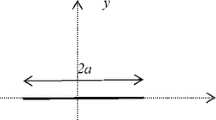Abstract
An analytic model is proposed for an opening mode of crack face displacement with crack-tip dual zones, i.e. an elastic core zone plus a plastic strip zone. A presence of such dual zones in the vicinity of the crack tip was experimentally observed in a recent study based on the generation of dislocations. A Papkovich-Neuber formulation of the resulting four-part mixed boundary value problem leads to a set of quadruple integral equations which are solved with an application of finite Hilbert transform technique. With conditions of boundedness on the stresses in the plastic strip zone, the results show an inverse square root of the distance type singularity at the base of the crack tip and a relaxation of stresses in the crack-tip elastic core zone is realized. The stress intensity factors and the crack-tip opening displacements are presented in exact forms involving elliptic integrals and Heuman's lambda function and are shown to depend upon the crack size, the applied loading and the crack-tip dual zone lengths. The analytic and graphical solutions are compared with the Dugdale model to which they reduce as a limiting case of vanishing elastic core zone.
Résumé
On propose un modèle analytique pour décrire la déformation d'ouverture selon le mode I, en utilisant une approche de mécanique des milieux continus pour décrire la double zone-élastique et plastique-située à la pointe d'une fissure.
Similar content being viewed by others
References
D.S. Dugdale, Journal of Mechanics and Physics of Solids (1960) 100–104.
J.N. Goodier and F.A. Field, in Fracture of Solids, eds, D.C. Drucker and J.J. Gilman, John Wiley, New York (1963) 103–118.
J.R. Rice, in Proceedings of the First International Conference on Fracture, Vol. 1 (1965) 283.
S.M. Ohr and S. Kobayashi, Journal of Metals 32 (1980) 35.
S.-J. Chang and S.M. Ohr, Journal of Applied Physics 12 (1981) 52.
B.S. Majumdar and S.J. Burns, International Journal of Fracture 21 (1983) 229–240.
J. Weertman, Acta Metallurgica 26 (1978) (1731–1738.
R. Thomson, Journal of Materials Science 13 (1978) 128–142.
B. Budiansky, J.W. Hutchinson and J.C. Lambropoulos, “Continuum theory of Dilatant transformation Toughening in Ceramics,” Report MECH-25, Division of Applied Sciences, Harvard University, Cambridge, Mass. (1982).
I.N. Sneddon, Mixed Boundary Value Problems in Potential Theory, J. Wiley, New York (1968).
A.K. Nagar, L.-S. Fu and D.A. Mendelsohn, “On Certain Quadruple Integrral Equations,” Journal of Elasticity, to appear.
A.K. Nagar, “The Fracture Mechanics of a Slit Crack with Crack-Tip Dual Zones,” Ph.D. dissertation, The Ohio State University (June 1984).
G.K. Dhawan and R.S. Dhaliwal, International Journal of Engineering Science (1978) 253–262.
P.F. Byrd and M.D. Friedman, Handbook of Elliptic Integrals for Engineers and Scientists, Springer-Verlag, New York (1971).
S.M. Ohr and S.-J. Chang, Journal of Applied Physics 53 (1982) 5645–5651.
S.-J. Chang and S.M. Ohr, International Journal of Fracture 23 (1983) R3-R6.
G. Hahn and A. Rosenfield, Acta Metallurgica (1965) 293–306.
J.C.M. Li, in Dislocation Modelling of Physical Systems, eds. M.F. Ashby, R. Bullough, C.S. Hartley and J.P. Hirth, Pergamon Press, London (1981) 23.
Author information
Authors and Affiliations
Rights and permissions
About this article
Cite this article
Nagar, A.K., Fu, L.S. Analysis of a crack-tip dual zone model. Int J Fract 28, 245–259 (1985). https://doi.org/10.1007/BF00035220
Received:
Revised:
Issue Date:
DOI: https://doi.org/10.1007/BF00035220




